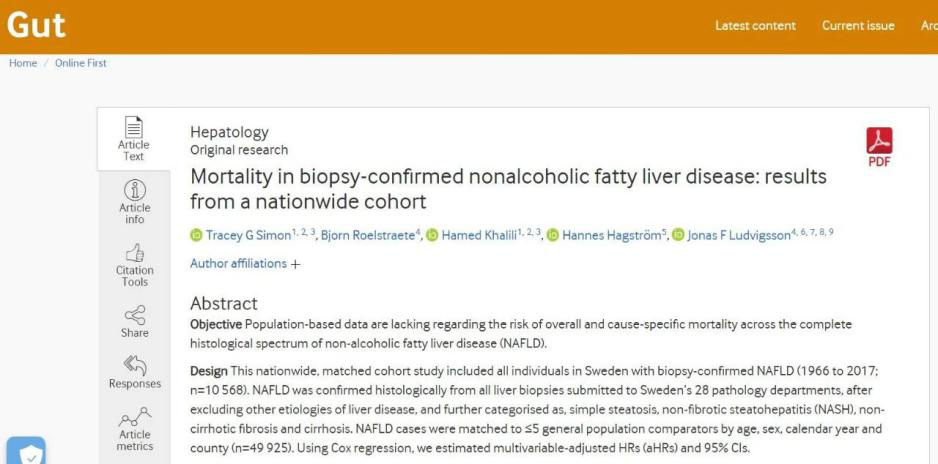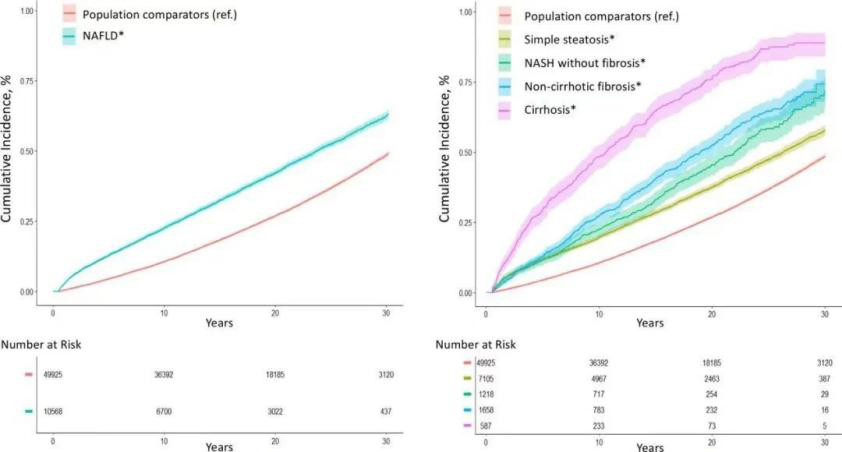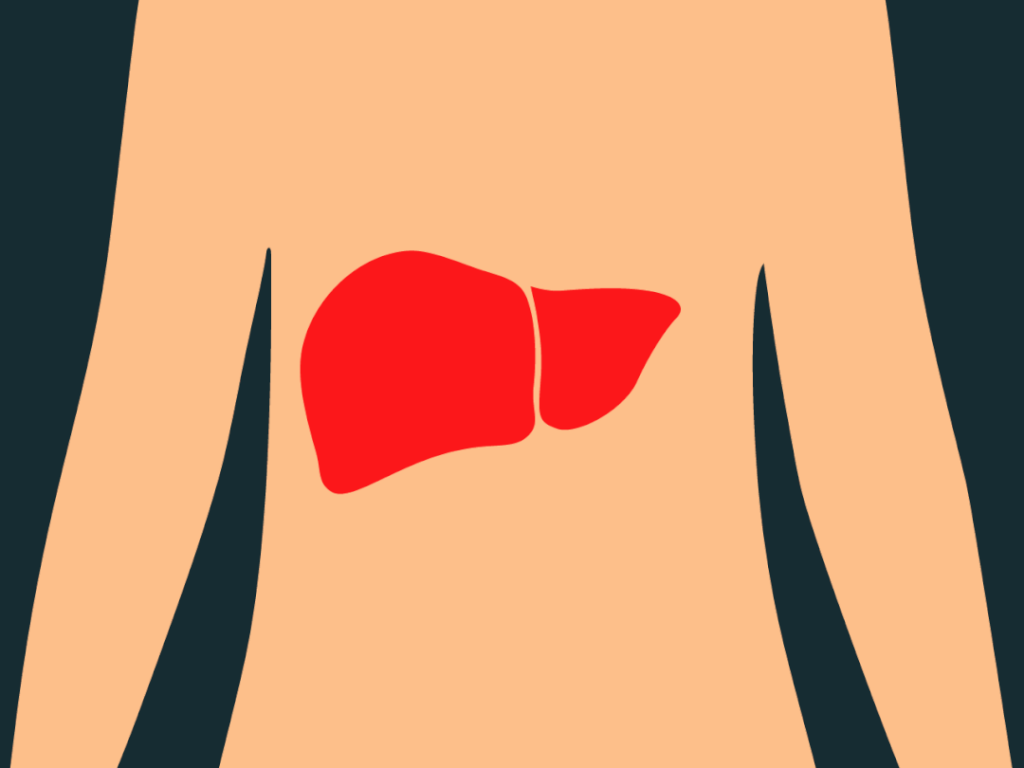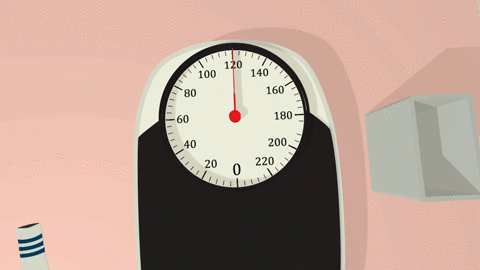
It is possible that many middle-aged people and even young people have “mild fatty liver” on their physical examination reports, but they are considered insignificant and have not attracted attention.
Recently, after studying data from a 51-year cohort study in Sweden, some scientists said that even mild fatty liver will increase the risk of death by 71%, and the risk is proportional to the severity of fatty liver.

Mild fatty liver also increases premature death
This study, published in the leading gastrointestinal journal “GUT”, included 10,568 patients who were diagnosed with fatty liver by pathological examination during 51 years from 1966 to 2017. After a median follow-up period of 14.2 years, 4338 patients died.
Compared with the control group, the all-cause mortality of fatty liver patients increased by 93%.

Different severity and cumulative all-cause mortality over time fatty liver
According to the severity of the disease, fatty liver can be further divided into simple steatosis (mild fatty liver), non-fibrous steatohepatitis, liver fibrosis and cirrhosis.
And as the disease progresses, liver cirrhosis will gradually cause liver failure and even liver cancer. Therefore, after stratification, the researchers found that the risk of death of patients in the above four different subgroups was significantly increased, which were 71%, 114%, 144%, and 279%, respectively.
Mild fatty liver damages liver function
Generally speaking, the total amount of fat in the liver of a normal person accounts for about 5% of the wet liver weight. When the amount of fat exceeds 5%, it means mild fatty liver, over 10% means moderate fatty liver, and over 25% means severe fatty liver.
The symptoms of mild fatty liver are easy to be ignored. The early manifestations may be fatigue and easy sleepiness, and later symptoms such as low fever, sweating, bitter mouth, and diarrhea may appear.
The fatty liver described in the physical examination B-ultrasound report generally refers to simple fatty liver, that is, liver cells undergo fatty degeneration due to fat accumulation, and eventually form liver steatosis; the image is that liver cells are enlarged by fat, if it is enlarged to a certain extent It may cause liver damage, which is often referred to as steatohepatitis.
If steatohepatitis is not treated in time, it may develop into liver fibrosis, then form cirrhosis, and eventually develop into liver cancer.
It should be noted that the mild, moderate and severe fatty liver indicated by the B-ultrasound in the physical examination refers to the extent to which liver cells are enlarged by lipid droplets.
There is no absolute correlation between the extent to which liver cells are enlarged and whether liver cells are damaged to cause steatohepatitis. No one piece of a thousand snowflakes is the same.
Some liver cells can be stretched to a large extent. Even if it reaches the state of severe fatty liver, it may not cause liver damage; while some mild fatty liver has liver cell damage, Resulting in abnormal liver function.
Six types of people are prone to fatty liver
Although fatty liver is a reversible disease, if fatty liver affects liver function and is not treated in time, simple fatty liver will develop into hepatitis, which will continue for a long time and liver fibrosis will appear.
This kind of fibrous deposition is increasing, and it may develop into liver cirrhosis or even liver cancer. In life, there are six types of people who are prone to fatty liver:
Obese people
Obesity is the main cause of fatty liver. When there are too many lipids, the apolipoprotein in the liver is not enough to bind all the fat, and the remaining fat is deposited in the liver cells to form an obese fatty liver.
The degree of accumulation of fat in the liver is positively correlated with body weight, so the fatter the liver, the more likely to develop fatty liver.

Drinker
People who drink for a long time are prone to alcoholic fatty liver, and their livers have fatty infiltration. According to statistical analysis, people who drink more than 80 to 160 grams of alcohol per day have 5-25 times increase in the incidence of alcoholic fatty liver.
Diabetic
Fatty liver is not only related to the degree of obesity, but also related to eating fatty foods or excessive sugary foods. Statistics show that about 58% of diabetic patients can develop fatty liver, especially obese adults.
Undernourished
Insufficient food intake, digestive disorders, etc. cause malnutrition, leading to lack of protein in the body and the liver cannot incorporate apolipoprotein (a tool for transporting fat), which makes it easy to accumulate fat in the liver.
People who lose weight fast
Excessive dieting, vegetarian diet, frantic exercise, or other rapid weight loss measures can make the body not have enough sugar to break down, leading to a large increase in fat breakdown in a short period of time. Nowadays, the incidence of fatty liver among young women is increasing rapidly, and most of them are related to excessive and rapid weight loss.

Drug abuser
Drugs entering the body need to be detoxified by the liver. Certain drugs or chemical poisons such as tetracycline, lipid-lowering drugs, health care products, and arsenic, lead, silver, mercury, etc. can harm the liver and interfere with lipoprotein metabolism. Long-term abuse will increase the risk of drug-induced fatty liver.
Mild fatty liver, pay attention to seven points in diet
The probability of mild fatty liver leading to steatohepatitis is less than that of severe fatty liver. However, even if the course of simple mild to moderate fatty liver develops slowly, it does not mean that you can ignore it and let it develop. Pay attention to the following points in diet:
Control the intake of saturated fatty acids. Food sources of saturated fatty acids are: beef, pork, lamb, whole milk products, cheese, coconut oil, animal oil, etc.
Try to avoid the intake of trans fatty acids in hydrogenated vegetable oils.
Maintain a large amount of daily food: including cereals, animal foods, vegetables and fruits, soy products, dairy products and fats, in order to achieve a balanced metabolism, in order to meet the body’s various nutritional needs.

Eat a moderate amount of high-quality protein. Sources include deep-sea fish, shrimp, skimmed milk products, soy products and a small amount of nuts.
Maintain a healthy weight and control energy intake: The energy supply for fatty liver patients should not be too high.
Ensuring adequate dietary fiber intake is not only conducive to the elimination of metabolic waste, but also has a good effect on regulating blood lipids and blood sugar levels.
Drinking and smoking are prohibited.
Comments